Action Movies: Kurt Kren & VALIE EXPORT
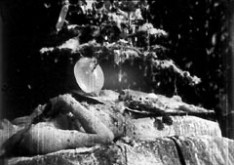
Kurt Kren, 9/64: O Tannenbaum (Materialaktion: Otto Muehl) (O Christmas Tree [An Otto Muehl Happening]), 1964
Thursday, November 12, 2015, 7:00 pm. Note the change from our usual day & time
In conjunction with work by Guenter Brus and VALIE EXPORT currently on display in MOCA’s permanent collection, Los Angeles Filmforum is proud to present a program of films and videos by Kurt Kren and VALIE EXPORT. Early in his remarkable career, Kren trained his camera and emerging hyper-rapid editing technique on Viennese Actionists Guenter Brus and Otto Muehl, but Kren’s films depart from straight documentation by using editing as both a constructive and destructive force. Quickly cutting between fragmented actions creates an incredible barrage of images moving forward and back in time. Later in the decade, VALIE EXPORT would begin staging her important, and often incendiary, contributions to Viennese performance art. Staging actions on the street and for the camera, EXPORT problematized many of the assumptions of the actions that preceded her while forging a new feminist language of art and image making.
Programmed by Madison Brookshire
Between 1964 and 1966, Kurt Kren (1929-1998) made a number of films based on “material actions” by Otto Muehl and Günter Brus, performed exclusively for Kren and several photographers. Due to these and others of his “serial montage” films, Kren is often considered one of the most influential experimental filmmakers. After participating in the Destruction in Art symposium in London in 1966 and touring the US in 1968, Kren became a leading figure in avant-garde film.
VALIE EXPORT (b. 1940) has been an influential and provocative figure on the international art scene for over three decades. Her practice includes film, video, photography, text and performance. Initially expanding the Viennese Actionist project to confront a complex feminist critique of the social and political body, her works achieve a compelling fusion of the visceral and the conceptual. —EAI
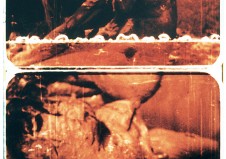
Kurt Kren, 6/64: Mama und Papa (Materialaktion Otto Mühl) [Mom and Dad (An Otto Muehl Happening)], 1964
6/64: Mama und Papa (Materialaktion Otto Mühl) [Mom and Dad (An Otto Muehl Happening)]
By Kurt Kren
1964, 16mm, color, silent, 4 minutes
Muehl’s Action is broken into extremely short fragments, some no more than a few frames long, and then intercut in repetitive patterns that move forward and back in time. The splices, visible as jagged white lines across the frame, are so numerous at times as to become the dominant visual impression. This incredible barrage of images has the perverse effect of prolonging each action–a kind of violence on the temporal plane that brings to mind Muehl’s tortured canvases even more than his happenings. —Madison Brookshire
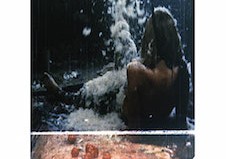
Kurt Kren, 7/64: Leda und der Schwan (Materialaktion: Otto Muehl) [Leda and the Swan (An Otto Muehl Happening)], 1964
7/64: Leda und der Schwan (Materialaktion: Otto Muehl) [Leda and the Swan (An Otto Muehl Happening)]
By Kurt Kren
1964 16mm, color, silent, 3 minutes
Kren´s film 7/64: Leda and the Swan is also based on a Muehl Materialaktion. The almost convulsive use of juxtaposition reappears here, but the captured gesture assumes a more erotic sensitivity, though the "action" itself was primarily a gradual destruction of the erotic. —Steven Dwoskin
8/64: Ana (Aktion Brus)
By Kurt Kren
1964, 16mm, black and white, silent, 3 minutes
With Ana - Aktion Brus, I saw that this was a good way of recording the whole action in single-frames. With the single frame shots, there was, of course, no cutting plan. Everything was done purely intuitively. There was not much to consider, and it all had to be done really quickly. (Kurt Kren)
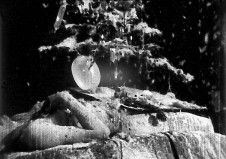
Kurt Kren, 9/64: O Tannenbaum (Materialaktion: Otto Muehl) (O Christmas Tree [An Otto Muehl Happening]), 1964
9/64: O Tannenbaum (Materialaktion: Otto Muehl) (O Christmas Tree [An Otto Muehl Happening])
By Kurt Kren
1964, 16mm, color, silent, 3 minutes
In 9/64: O Christmas Tree Kren offers a more visually descriptive development of a Muehl "action". The images have been chosen to follow a more dramatic sequence, probably because the action itself contained a wide range of images and materials. —Stephen Dwoskin
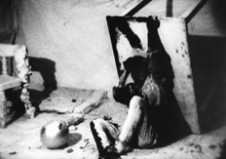
Kurt Kren, 10A/65: Silberaktion Brus (Silver - Action Brus), 1965
10A/65: Silberaktion Brus (Silver - Action Brus)
By Kurt Kren
1965, 16mm, black and white, silent, 2 minutes
In the films Kren made during the Günter Brus "Actions," plasticity is expunged. In contrast to the Muehl films, the body stretches out of the material and because of this becomes more difficult to differentiate from its environment, from the other objects. —Michael Palm
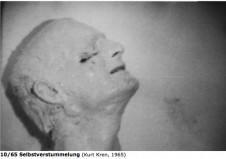
Kurt Kren, 10/65: Selbstverstuemmelung (Self-Mutilation), 1965
10/65: Selbstverstuemmelung (Self-Mutilation)
By Kurt Kren
1965, 16mm, black and white, silent, 6 minutes
What [this] film emphasizes is the surrealistic drama of symbolic self-destruction that Kren drew out of Brus's action, pacing out each gesture so that one gets a tense, iconoclastic revelation of a man covered in white plaster lying surrounded by razor blades and a range of instruments looking as if they have been taken from an operating theater. The blades, scissors and scalpels are gradually inserted into him in a ritualistic self-operation. —Stephen Dwoskin
13/67: Sinus Beta
By Kurt Kren
1967, 16mm, black and white, silent, 6 minutes
Montage of several shots, as from actions of Muehl and Brus at DIAS 1966 in London, from my film 2/60: 48 HEADS FROM THE SZONDI TEST, etc. —Kurt Kren
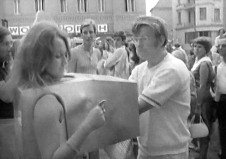
VALIE EXPORT, Tapp und Tastkino (Touch Cinema), 1968, courtesy of Electronic Arts Intermix
Tapp und Tastkino (Touch Cinema)
By VALIE EXPORT
1968, Video converted to digital file, black and white, sound, 1 minute
"In the majority of commercial films the forbidden revolves around the body of woman… In Touch Cinema the voyeurism is undercut by reversing the cinematic viewing situation. Instead of being able to hide in a dark room… the spectator is encouraged to engage in the “real thing”—but out in the open, where he can be seen by everybody. For this purpose Export strapped a mini-movie theater (plastic or metal box with curtains) over her bare chest while Peter Weibel exhorted the passersby to participate." —Roswitha Mueller
"[A] true woman’s film… woman’s first step from object to subject. She disposes of her breasts freely and no longer follows social prescriptions; the fact that everything happens in the street and the “consumer” can be anybody. i.e., man or woman, constitutes an undisguised infraction of the homosexuality taboo."—VALIE EXPORT (as quoted in Mueller)
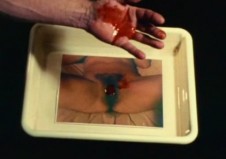
VALIE EXPORT Mann & Frau & Animal (Man & Woman & Animal),1973, courtesy of Electronic Arts Intermix
Mann & Frau & Animal (Man & Woman & Animal)
By VALIE EXPORT
1973, 16mm, color, sound, 10 minutes
Instead of the holy trinity: father son holy spirit, instead of the profane trinity: mother family state, instead of the social trinity: father mother child, the film treats the real trinity in three sections. What unites man and woman (not alone for sure, but what is being concealed) is the history of nature. —VALIE EXPORT
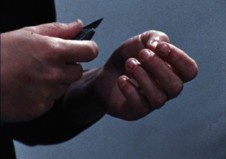
VALIE EXPORT, ...Remote...Remote..., 1973, courtesy of Electronic Arts Intermix
...Remote...Remote...
By VALIE EXPORT
1973, 16mm, color, sound, 12 min.
Human behavior in contract to machines (animals) is influenced by events in the past, as long as these experiences may lay back. Therefore there exists a psychic para-time parallel to the objective time, where the prayers of anguish and guilt, the inability to win, deformations which rip open the skin, the becoming manifest of oneself have their constant effects. I demonstrate something which represents past and present. —VALIE EXPORT
